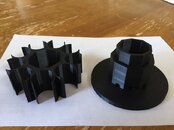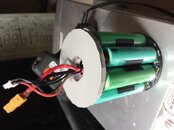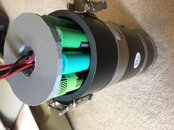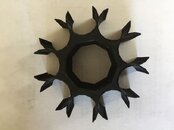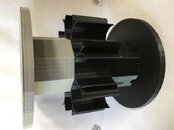I guess a beautiful problem ....yeah everyone needs a hobby that has countless upgrade options! I don’t have the printer yet but have one upgrade on order and (so I’m told) will want a few more to have really nice setup. Seems I heard something similar back in ‘93 when I took up another hobby frequently discussed on SB. Multiple sets of gear later, a dozen plus tanks, and a room full of supplies and tools later...maybe I do have a problem....
You are using an out of date browser. It may not display this or other websites correctly.
You should upgrade or use an alternative browser.
You should upgrade or use an alternative browser.
3D printing...
- Thread starter The Chairman
- Start date
Please register or login
Welcome to ScubaBoard, the world's largest scuba diving community. Registration is not required to read the forums, but we encourage you to join. Joining has its benefits and enables you to participate in the discussions.
Benefits of registering include
- Ability to post and comment on topics and discussions.
- A Free photo gallery to share your dive photos with the world.
- You can make this box go away
Skulmoski
Contributor
OK, how many of us are 3D printing Scuba gear? I'm beginning to learn, but I haven't printed anything specifically for Scuba yet. So far I've printed a Ryobi Battery socket for my backpack sprayer and a couple of Amazon DOT holders for around the house. I'm working with OnShape to create a 4S-3P Battery holder in a hex shape for my canister light. I also want to build some plugs for my hoses on my SF2 so they can drain and keep critters out at the same time. That will mean more CAD time and to think that yesterday I couldn't even spell CAD.


Marcel at Under the Jungle has been printing innovative products. Good luck!
ScubaBunga
Contributor
ok, finally got some pics. These are for my canister battery pack. This is a 3S/3P 12v battery pack. I made some out of wood last year, these are much better. It took me a while to get these right as tinkercad does not correctly center 9 sided shapes!! The original AGM battery lasts about an hour and is heavy. This pack lasts several hours and there is room in the canister for two of these packs. I could do a week of night dives and not need to recharge! The pack is setup to be able to plugged into a charger assembled, or the batteries can be removed and charged individually (and of course while traveling).
Attachments
What’s the best beginner 3D printer for scuba stuff?
Though there could be a lot of answers to this question, 2 years ago, when I started printing, I decided to go with the Creality Ender 3. It's a simple printer that prints more or less ok from the start at a reasonable price.What’s the best beginner 3D printer for scuba stuff?
Of course there are some others like the original Prusa printers, but are expensive.
Some added functions like silent printing, autolevel, several filament feeders, are nice, but are also expensive.
The Ender-3 needs some "upgrades" to print better, several of those upgrades can be printed directly with the printer. Some others need external work, like an enclosure.
Printing scuba stuff means (for me, though this can be discussed) ABS, PETG, 100% infill and extensive use of black filament.
OTF
Coney Island Whitefish Biologist
"Best beginner printer" depends on budget. It's incredible what the cheap ones can do these days, but in general the more expensive printers will be a significant step up in reliability.
I print A LOT and reliability is worth paying for in my opinion because printers get fussy and frustrating when things go wrong.
I print A LOT and reliability is worth paying for in my opinion because printers get fussy and frustrating when things go wrong.
What’s the best beginner 3D printer for scuba stuff?
I own an Ender 3. Its $600 less than a Prusa. The Prusa is a better printer, hands down....but comparing my prints to that of the Prusa I don't see a $600 difference.
A big part of the answer depends on how much of a hobby you want to make it. 3D printing is nowhere near the point of "just click print" yet.... even the best printer will require you figuring out the print settings for different materials (even different spools of the "same" material... I have 2 brands of ABS that I have completely different profiles for). Most printers these days can do what you need for small/medium scuba parts.... Like emoreira, I use ABS or PETG for functional prints, but others have used PLA without issue. Where this comes into play, is that for ABS (and many other materials outside of PLA and TPU) you need a heated bed, and for ABS particularly an enclosure helps a lot (but can be added or built later). If I knew then what I know now, I would probably get an Ender3 and build a simple enclosure to help prevent warping on bigger ABS prints. Only thing against that, is if you want to print flexible filaments (like TPU).... in which case you want something with a direct drive extruder (not bowden tube).What’s the best beginner 3D printer for scuba stuff?
Respectfully,
James
What’s the best beginner 3D printer for scuba stuff?
I can't say what is the best, but I went with the Ender 5 Pro (refurbished to save some money) after talking with my sister and her husband who have been 3d printing for years. The only upgrade I found desirable out of the gate was adding a BLTouch for auto-leveling. I may do other things in the future, but for now it does all the stuff I need and it does it pretty well.
Be aware that if you want to do more than print what others have designed you're also going to need to learn to use some design software (I've used Fusion 360, 3D Builder, and Tinkercad so far myself).
This and then some! I myself use FreeCad (can't beat the price, and it will run on a potato). The infinite university of youtube provided the initial tutorials to get me rolling with it.Be aware that if you want to do more than print what others have designed you're also going to need to learn to use some design software (I've used Fusion 360, 3D Builder, and Tinkercad so far myself).
Respectfully,
James
Similar threads
- Replies
- 28
- Views
- 1,473
- Replies
- 15
- Views
- 1,437
- Replies
- 0
- Views
- 979
- Replies
- 20
- Views
- 3,750




